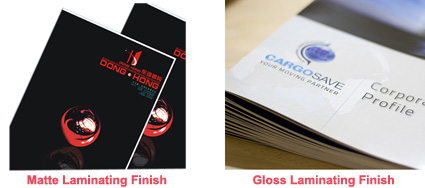Matt & Gloss Laminating
 Description
Description
Laminating is the process of applying a film to either one side or both sides of a printed document. The use of lamination serves several purposes:
Lamination can be a useful and often necessary addition to various products including posters, maps, membership cards, calendars, food labels, menus, signs, price tags, ID cards, point-of-sale materials, business cards, charts, photographs, placemats, badges, covers, certificates, and many others.
Methods of Lamination
Thermal Lamination
The laminate usually consists of 2 plies with each ply made up of an over laminate film and an adhesive, which is dry and not tacky to the touch. A heat source and pressure are required during the lamination process. The document is placed between the two plies of the laminate film and then sent through equipment where the dry adhesive is made tacky by heat and is pressed onto the document under high pressure. After cooling, the adhesive solidifies and provides a permanent bond between the document and laminate film.
Cold Lamination
Cold lamination is a process in which only one side of a document is laminated. This laminating process is required when the ink and/or paper used for a document is too sensitive to the heat required with thermal lamination. The film used for cold lamination is much more costly than for thermal lamination, but the equipment is less expensive. One method of cold lamination utilizes a process where no dry adhesive is used as in thermal lamination. The surface of a document is flooded with a water-soluble adhesive. It is then sent through a set of rollers with the laminating film rolled onto the top of the document and the adhesive. Pressure is applied which evenly distributes the adhesive and bonds the film to the document. The adhesive takes a bit longer to cure than thermal lamination and lighter stocks can wrinkle or warp because of the water based adhesive. Cold lamination may not be as permanent as thermal lamination.

